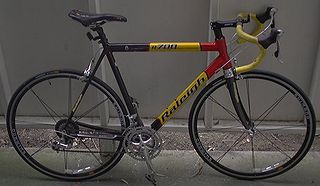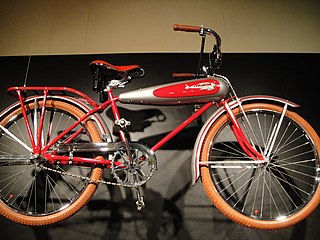
The Schwinn Paramount was a high-end racing bicycle produced under the Schwinn Bicycle Company brand from 1938 through 2009. [1]

The Schwinn Paramount was a high-end racing bicycle produced under the Schwinn Bicycle Company brand from 1938 through 2009. [1]
In the 1930s, Schwinn sponsored a bicycle racing team headed by Emil Wastyn, who designed the team bikes, and the company competed in six-day racing across the United States with riders such as Jerry Rodman and Russell Allen. In 1938, Frank W. Schwinn officially introduced the Paramount series. Developed from experiences gained in racing, Schwinn established Paramount as their answer to high-end, professional competition bicycles. The Paramount used high-strength chrome-molybdenum steel alloy tubing and expensive brass lug-brazed construction. During the next twenty years, most of the Paramount bikes would be built in limited numbers at a small frame shop headed by Wastyn, in spite of Schwinn's continued efforts to bring all frame production into the factory.
On 17 May 1941, Alfred Letourneur was able to beat the motor-paced world speed record on a bicycle, reaching 108.92 miles per hour (175.29 km/h) on a Schwinn Paramount bicycle [2] riding behind a car in Bakersfield, California.
While many large bicycle manufacturers sponsored or participated in bicycle racing competition of some sort to keep up with the newest trends in technology, Schwinn restricted its racing activities to events inside the United States, where Schwinn bicycles predominated. As a result, Schwinns became increasingly dated in both styling and technology. By 1957, the Paramount series, once a premier racing bicycle, had atrophied from a lack of attention and modernization. Aside from some new frame lug designs, the designs, methods and tooling were the same as had been used in the 1930s. After a crash-course in new frame-building techniques and derailleur technology, Schwinn introduced an updated Paramount with Reynolds 531 double-butted tubing, Nervex lugsets and bottom bracket shells, as well as Campagnolo derailleur dropouts. The Paramount continued as a limited production model, built in small numbers in a small apportioned area of the old Chicago assembly factory. The new frame and component technology incorporated in the Paramount largely failed to reach Schwinn's mass-market bicycle lines. Another change occurred in 1963 following the death of F. W. Schwinn, when grandson Frank Valentine Schwinn took over management of the company.
In the early 1970’s, Mainland built a number of the all chrome Paramounts, using Nervex lugs. In an interview with Mainland, he indicated that his frames were very well-received by Schwinn, for their superior workmanship.
A growing number of teens and young adults were purchasing imported European sport racing or sport touring bicycles, many fitted with multiple derailleur-shifted gears. Schwinn decided to meet the challenge by developing two lines of sport or road 'racer' bicycles. One was already in the catalog — the limited production Paramount series. As always, the Paramount spared no expense; the bicycles were given high-quality lightweight lugged steel frames using double-butted tubes of Reynolds 531 and fitted with quality European components including Campagnolo derailleurs, hubs, and gears. The Paramount series had limited production numbers, making vintage examples quite rare today.
The period of 1965–1975 saw adult cycling increase sharply in popularity. More and more cyclists, especially younger buyers, began to insist on stronger steel alloys (which allowed for lighter frames), responsive frame geometry, aluminum components, advanced derailleur shifting, and multiple gears. [3] [4] While the Paramount sold in limited numbers to this market, the model's customer base began to age, changing from primarily bike racers to older, wealthier riders looking for the ultimate bicycle. Schwinn sold an impressive 1.5 million bicycles in 1974, but would pay the price for failing to keep up with new developments in bicycle technology and buying trends.
Schwinn also marketed a top-shelf touring model from Panasonic, the World Voyager, lugged with butted Tange chrome-molybdenum alloy tubing, Shimano derailleurs, and SunTour bar-end shifters, a serious challenge to the Paramount series at half the price. [5] [6]
Schwinn brand loyalty began to suffer as huge numbers of buyers came to retailers asking for the latest sport and racing road bikes from European or Japanese manufacturers. By 1979, even the Paramount had been passed, technologically speaking, by a new generation of American as well as foreign custom bicycle manufacturers.
In 1993, Richard Schwinn, great-grandson of Ignaz Schwinn, with business partner Marc Muller, purchased the Schwinn Paramount plant in Waterford, Wisconsin, where Paramounts were built since 1980. They founded Waterford Precision Cycles, which produced the Paramount for Schwinn until September 1994 when the line was retired. [7] [8]
In late 1997, Questor Partners Fund purchased Schwinn Bicycles (and later GT Bicycles) and in 1998 reintroduced the Paramount line. In 2001, Schwinn/GT declared bankruptcy and was acquired by Pacific Cycle and later Dorel Industries, who marketed the Paramount line through 2009.

The term road bicycle is used to describe bicycles built for traveling at speed on paved roads. Some sources use the term to mean racing bicycle. Other sources specifically exclude racing bicycles from the definition, using the term to mean a bicycle of a similar style but built more for endurance and less the fast bursts of speed desired in a racing bicycle; as such, they usually have more gear combinations and fewer hi-tech racing features. Certain of these bicycles have been referred to as 'sportive' bicycles to distinguish them from racing bicycles.

A bicycle frame is the main component of a bicycle, onto which wheels and other components are fitted. The modern and most common frame design for an upright bicycle is based on the safety bicycle, and consists of two triangles: a main triangle and a paired rear triangle. This is known as the diamond frame. Frames are required to be strong, stiff and light, which they do by combining different materials and shapes.

A derailleur is a variable-ratio bicycle gearing system consisting of a chain, multiple sprockets of different sizes, and a mechanism to move the chain from one sprocket to another.
Campagnolo is an Italian manufacturer of high-end bicycle components with headquarters in Vicenza, Italy. The components are organised as groupsets (gruppi), and are a near-complete collection of a bicycle's mechanical parts. Campagnolo's flagship components are the Super Record, Record, and Chorus groupsets with all three representing their recent shift to 12-speed drivetrains. Super Record and Record are the top groupsets, followed by Chorus, Potenza, Centaur and Veloce. Campagnolo also produces aluminum and carbon wheels, as well as other components.

Reynolds 531 is a brand name, registered to Reynolds Technology of Birmingham in the United Kingdom, for a manganese–molybdenum, medium-carbon steel tubing that was used in many quality applications, including race car chassis, aircraft components and, most famously, bicycle frame tubing. It is one of a number of tubing types developed by Reynolds.

A racing bicycle, also known as a road bike is a bicycle designed for competitive road cycling, a sport governed by and according to the rules of the Union Cycliste Internationale (UCI).

The Schwinn Bicycle Company is an American company that develops, manufactures and markets bicycles under the eponymous brand name. The company was originally founded by Ignaz Schwinn (1860–1948) in Chicago in 1895. It became the dominant manufacturer of American bicycles through most of the 20th century. After declaring bankruptcy in 1992, Schwinn has since been a sub-brand of Pacific Cycle, owned by the Dutch conglomerate, Pon Holdings.

The Raleigh Chopper is a children's / young adults bicycle, a wheelie bike, manufactured and marketed from the 1960s to 2005 by the Raleigh Bicycle Company of Nottingham, England. Its unique design became a cultural icon and is fondly remembered by many who grew up in that period. The design was influenced by dragsters, "chopped" motorcycles, beach buggys, and even chariots, as can be seen on the centre page of the 1969 Raleigh US catalogue.The bicycle has featured in many movies and TV series including the Goonies, MK1 models produced from 1967 to 1973, MK2 models produced from 1973 to 1985 and MK3 models produced from 1996 to 2005

Tom Ritchey is an American bicycle frame builder, Category 1 racer, fabricator, designer, and founder of Ritchey Design. Ritchey is a US pioneer in modern frame building and the first production mountain bike builder/manufacturer in the history of the sport. He is an innovator of bicycle components that have been used in winning some of the biggest cycling competitions in the world including the UCI World Championships, the Tour de France and the Olympics. In 1988, Ritchey was inducted into the inaugural Mountain Bike Hall of Fame in Crested Butte, Colorado : and 2012, inducted to the United States Bicycle Hall of Fame in Davis, California.

A roadster bicycle is a type of utility bicycle once common worldwide, and still common in Asia, Africa, Latin America, and some parts of Europe. During the past few decades, traditionally styled roadster bicycles have regained popularity in the Western world, particularly as a lifestyle or fashion statement in an urban environment.

A cruiser bicycle, also known as a beach cruiser or (formerly) motobike, is a bicycle that usually combines balloon tires, an upright seating posture, a single-speed drivetrain, and straightforward steel construction with expressive styling. Cruisers are popular among casual bicyclists and vacationers because they are very stable and easy to ride, but their heavy weight and balloon tires tend to make them rather slow. Another common feature is their ability to be customized with accessories including fenders, lights and saddle bags. They are designed for use primarily on paved roads, low speeds/distances, and are included in the non-racing/non-touring class and heavyweight or middleweight styles of the road bicycle type.

Keith Kingbay was a racer, manufacturer, advocate, and author in bicycling. He was raised in Kenosha, Wisconsin, USA, and became a road and track racing cyclist in the 1940s before moving to Chicago to work for the Schwinn Bicycle Company.

Miyata is a Japanese manufacturer of bicycles, unicycles and fire extinguishers. The company has been in operation since 1890. Miyata was also one of the first producers of motorcycles in Japan under the name Asahi. The Asahi AA was the first mass-produced motorcycle in Japan.
Waterford Precision Cycles is a small bicycle manufacturer based in Waterford, Wisconsin. Waterford produces high-end, custom, hand-built, steel-frame bicycles, particularly road, criterium, stage, track, and cyclocross racing bicycles, that range in price from about $2,500 to $8,500. Waterford builds both TIG welded and lugged steel frames to order, and specializes in custom and unique bicycle frames.

The Panasonic Sport Deluxe is a road sport bicycle by National, which was exported to the United States from 1971 to 1989. Originally built in Osaka, Japan, later bikes may be either of Japanese or Taiwanese origin.
Univega is a bicycle brand created during the bike boom of the 1970s by Ben Lawee (1926–2002), who founded Lawee Inc. to design, specify, and import bicycles initially manufactured in Italy by Italvega, and subsequently in Japan by Miyata.

The Chicago Bicycle Company was a short-lived American bicycle company which operated from 1994 to 1998. It was headquartered in Burlington, Vermont, with its main production facilities in Chicago.
Centurion was a brand of bicycles created in 1969 by Mitchell (Mitch) M. Weiner and Junya (Cozy) Yamakoshi, who co-founded Western States Import Co. (WSI) in Canoga Park, California to design, specify, distribute and market the bicycles. The bikes themselves were manufactured initially in Japan by companies including H. Teams Company of Kobe and later in Taiwan by companies including Merida. The Centurion brand was consolidated with WSI's mountain bike brand DiamondBack in 1990. WSI ceased operations in 2000.

Cycles Peugeot, founded in 1882, is a manufacturer of bicycles based in Sochaux, France and currently a part of Cycleurope, a subsidiary of Sweden-based firm Grimaldi Industri.